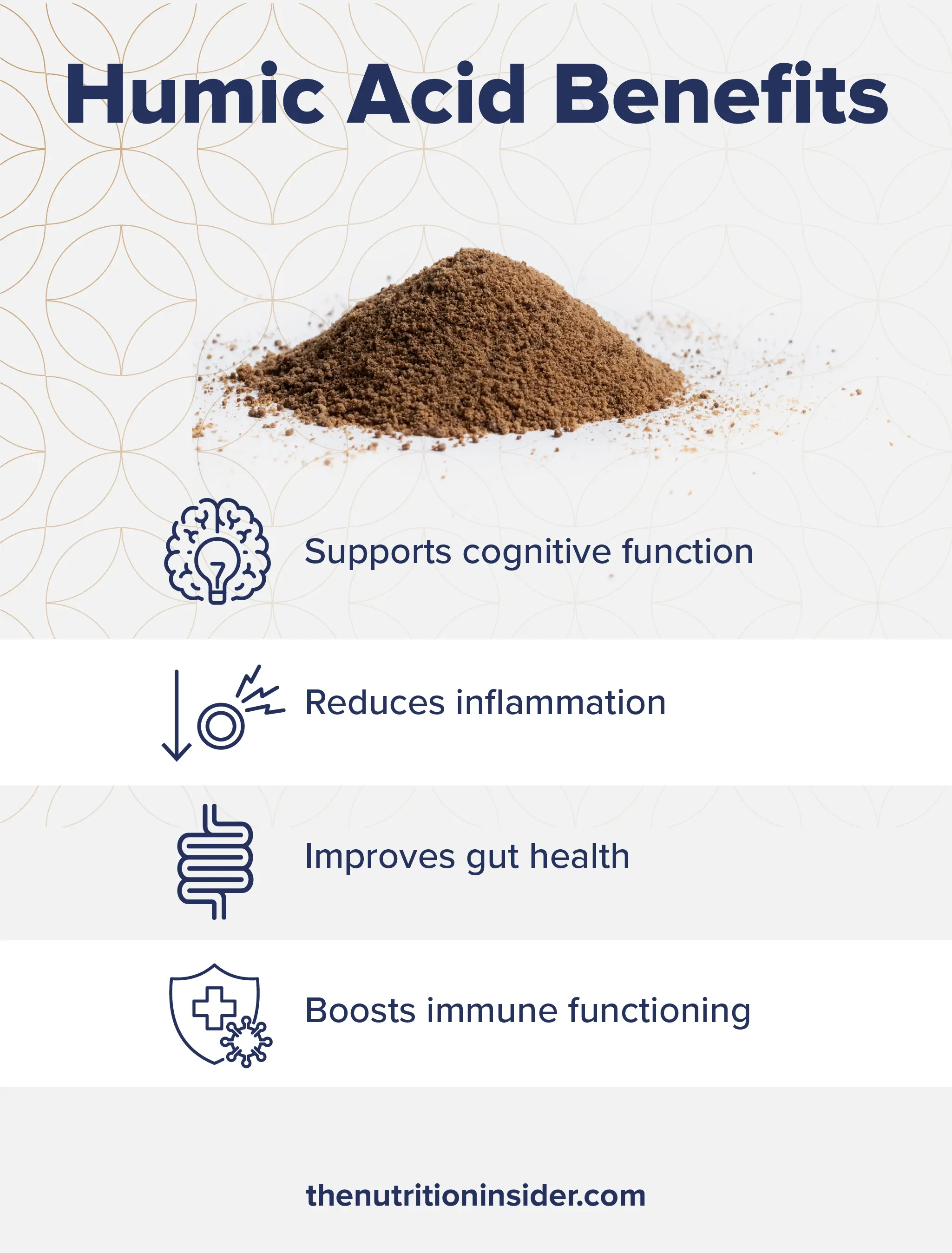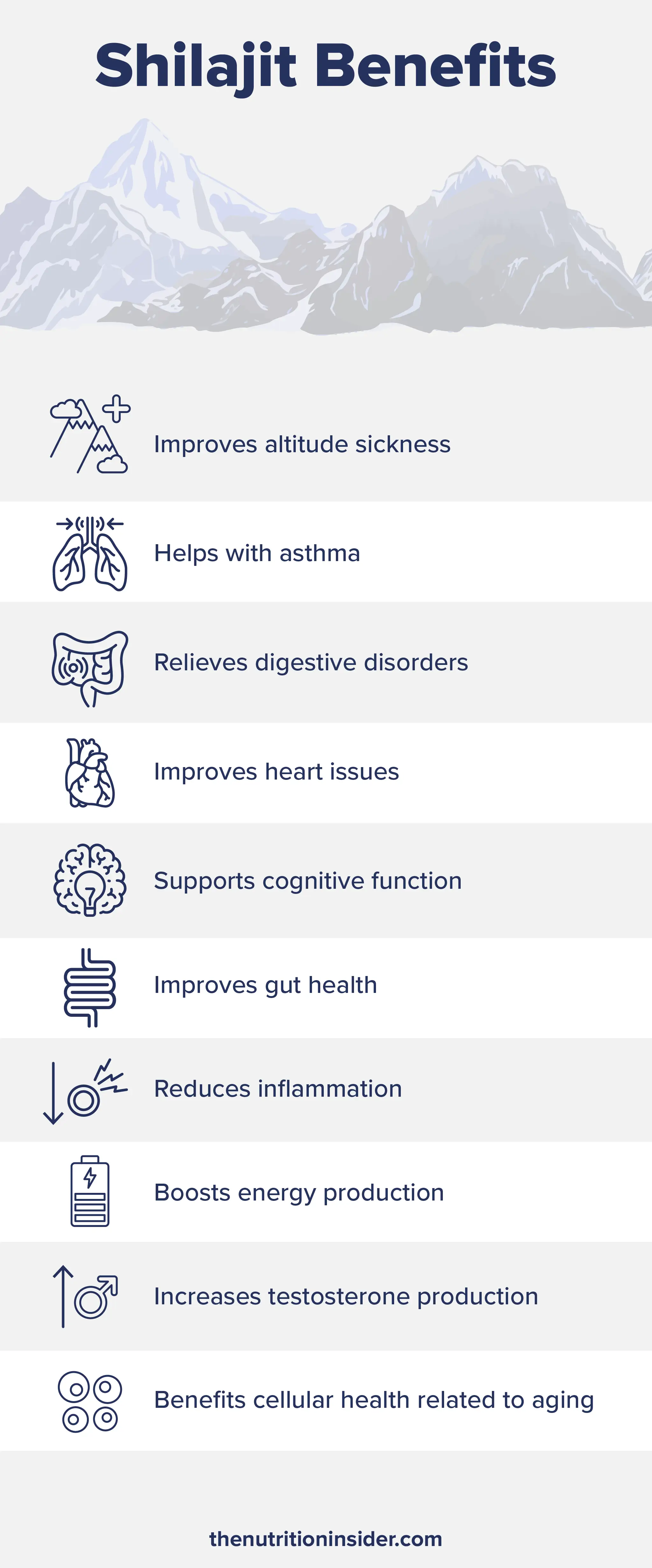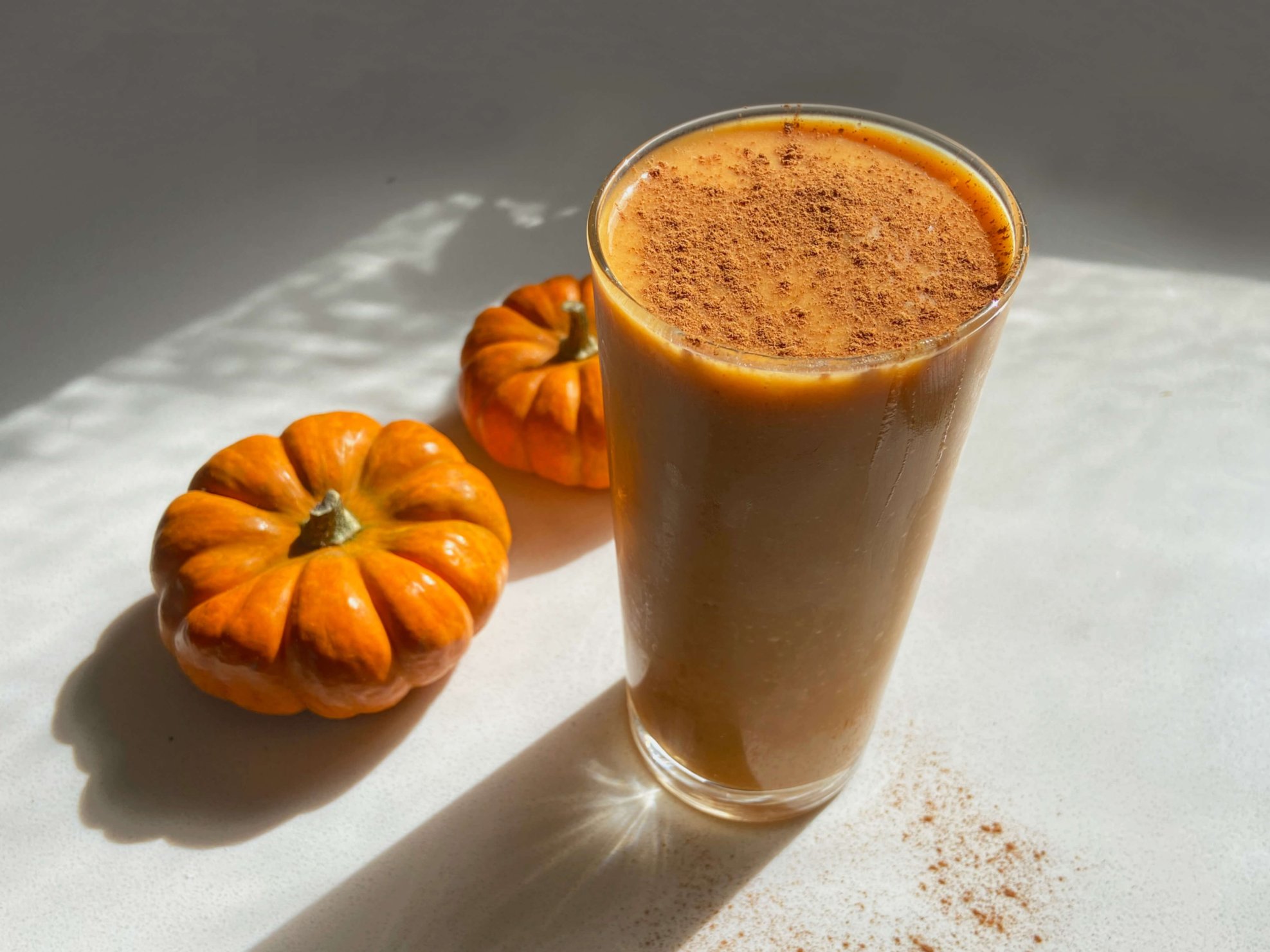This post contains links through which we may earn a small commission should you make a purchase from a brand. This in no way affects our ability to objectively critique the products and brands we review.
What is Shilajit, Fulvic Acid, and Humic Acid? Benefits for Gut Health and More
Evidence Based Research To fulfill our commitment to bringing our audience accurate and insightful content, our expert writers and medical reviewers rely on carefully curated research.
Read Our Editorial Policy
Shilajit (pronounced “shee-luh-jeet”) is a natural substance from the Himalayan mountains that has been used for centuries in traditional Ayurvedic healing practices.
Now, shilajit supplements have hit the modern wellness scene, but you may have also heard of fulvic acid and wondered if that’s the same.
While shilajit and fulvic acid are similar, as fulvic acid is a component of shilajit, they also have some important differences.
But to understand shilajit and fulvic acid, we first need to understand humic acid—the substance that they come from. Let’s dive into the details about shilajit, fulvic acid, and humic acid, including how they can benefit gut health and more.
What Is Humic Acid?
Humic acids are complex organic substances found in soil (you may have heard of humus, the dark material from plant and animal matter decaying in soil found on forest floors or compost piles).
Humus forms when soil microorganisms break down organic matter. When those microorganisms die, they are broken down and added to the decomposing buildup, leading to some regions having humus going deep into the earth that’s thousands or millions of years old.
Although the thought of consuming bacteria-eaten decomposing matter sounds a bit more zombie-like than you’d probably prefer, the unique microbial components of humic substances are thought to benefit our microbe-rich guts in similar ways to fermented food.The benefits of humus have been known for thousands of years, with writings about using the microbe-rich soil for medicinal purposes going back to ancient Rome and China.1 Recent research has backed this up, showing that supplementing with humic acid increases the growth of healthy gut bacteria.1

What Is Shilajit?
Shilajit is a blackish-brown humic substance secreted by high-altitude rocks in specific mountain ranges, especially the Himalayas between India and Nepal. However, it’s also been found in Russia, Tibet, Afghanistan, and the Andes of Chile (known as Andean Shilajit).
Shilajit is derived from decomposed matter (humus) and contains bioactive compounds like humic acid, fulvic acid, selenium, and 84 other minerals.2
It’s also rich in antioxidants that come from these compounds. Some preliminary research suggests that shilajit may even have a higher antioxidant content than blueberries, although more studies are needed to verify.2
Other molecules in shilajit that may contribute to its health benefits are triterpenes, sterols, amino acids, polyphenols, polysaccharides, lignans, and phenolic lipids.
The chemical makeup of shilajit can vary widely depending on where it comes from, which makes sense as it is composed of the decaying matter of that region.
In Ayurvedic medicine practices, shilajit has been used to treat conditions like altitude sickness, asthma, digestive disorders, and heart issues.
Nepalese and North Indian people traditionally consume shilajit with milk in the morning, which may contribute to the long lives and extreme strength of Himalayan Sherpas.
Meaning “’conqueror of mountains” or “conqueror of the rocks” in Sanskrit, other names for shilajit include mineral pitch, salajit, shilajatu, mimie, or mummiyo—the last two coming from its use by the ancient Egyptians for mummification.

What Is Fulvic Acid?
Fulvic acid (sometimes called fulvate) is a type of humic substance that gets extracted and purified from shilajit or humus.
It’s rich in antioxidants and is the leading bioactive substance found in shilajit, so many supplement manufacturers extract it from shilajit.
However, fulvic acid does not have several of the other beneficial compounds found in shilajit, including minerals, polyphenols, polysaccharides, and more.
Fulvic acid is thought to work well as a supplement because it has a small molecular size and is soluble in water at different pHs, meaning it can be easily absorbed into the digestive tract and utilized.
Because of its solubility and small size, fulvic acid acts as a carrier molecule, which can help to transport nutrients and compounds in other tissues.
Benefits of Shilajit and Fulvic Acid
As fulvic acid is the primary bioactive component of shilajit, the health benefits of the two often overlap, including supporting cognitive function, gut health, and reducing inflammation.3
However, fulvic acid may benefit gut health and immune functioning more, while shilajit may be best for helping with altitude sickness, testosterone production, energy production, and cellular health related to aging.2
Both shilajit and fulvic acid have been shown to benefit brain health and cognitive function. One study found that the Andean form of shilajit stimulated cognitive activity in mice, including increasing the number and length of neuronal processes.4
Other animal studies have shown that shilajit improves outcomes after traumatic brain injury by reducing swelling and brain pressure in rats.5
Similarly, fulvic acid has been shown in a cell-based study to inhibit the aggregation of tau proteins, which are characteristic of Alzheimer’s disease.6
Both shilajit and fulvic acid may support gut health, as it’s made of microbe-rich humus. Research suggests that shilajit and fulvic acid can shift the gut microbiome to a healthier state, increase nutrient absorption in the gut, and increase digestive enzyme activity.7
A clinical trial with the fulvic acid supplement ION* Gut Support found that it reduced zonulin by 12%—a marker of intestinal permeability (leaky gut) and impaired gut barrier function. This fulvic acid supplement also reduced the pro-inflammatory cytokine IL-6 and urine levels of the pesticide glyphosate by 23%, suggesting its detoxifying properties.8
Fulvic acid also helps with iron absorption, making it available for red blood cell formation. In addition to shilajit improving oxygen levels, this is one reason why it is beneficial for helping with hypoxic conditions at high altitudes.2
Some other potential benefits of fulvic acid and shilajit include:
- Lowering blood cholesterol: An older study found that a group of Indian medical students (median age 24) who took shilajit for 45 days (2 grams, split into four equal doses) had significant reductions in serum triglycerides and increased HDL cholesterol.9
- Improving mitochondrial function: Research with rats showed that shilajit prevented mitochondrial dysfunction and reversed oxidative stress in the mitochondria.10
- Anti-cancer properties: In a cell-based study, shilajit induces cancer cell death (apoptosis) and prevents the growth and spread of liver cancer cells.11
- Boosting testosterone: A study of 96 men found that taking 500 mg of shilajit per day for three months significantly increased testosterone and DHEA-S levels.12
- Increasing muscle strength: Likely because of the testosterone-boosting properties, studies have shown that shilajit increases muscle strength. Uniquely, we have human studies here—one 12-week study of adults with obesity and another 8-week trial with active men both found evidence of muscle growth.13,14
Overall, both shilajit and fulvic acid appear to be beneficial supplements. Fulvic acid has the benefit of being more concentrated in fulvic acid, while shilajit has the added benefits of other minerals and bioactive compounds. Although shilajit has been consumed for millennia, more research in humans is still needed to verify its (and fulvic acid’s) benefits.
Shilajit Vs. Fulvic Acid FAQs
What are the benefits of Shilajit?
The benefits of shilajit come from its antioxidants, minerals, and fulvic acid composition. Some of the potential benefits of shilajit include gut microbiome health, cognitive function, reduced inflammation, increased testosterone, energy production, mitochondrial health, muscle growth, and anti-cancer activity. However, shilajit needs to be studied more in humans.
Is shilajit the same as fulvate?
Fulvate, or fulvic acid, is one component of shilajit. Fulvic acid is often extracted and purified from shilajit, making more concentrated supplements. Both fulvic acid and shilajit have many overlapping health benefits. However, fulvic acid may benefit gut health and immune functioning more, while shilajit may be best for helping with altitude sickness, testosterone production, energy production, and cellular health related to aging.
Is humic extract the same as fulvic acid?
Fulvic acid, humic extract, and shilajit are all considered humic substances, meaning they are derived from humus—the microbe-rich soil from decaying plant and animal matter. Humic acid is much larger than fulvic acid, meaning that fulvic acid is better absorbed and can act as a transporter for other nutrients in the body.
- Swidsinski, A., Dörffel, Y., Loening-Baucke, V., Gille, C., Reißhauer, A., Göktas, O., Krüger, M., Neuhaus, J., & Schrödl, W. (2017). Impact of humic acids on the colonic microbiome in healthy volunteers. World journal of gastroenterology, 23(5), 885–890. https://doi.org/10.3748/wjg.v23.i5.885
- Meena, H., Pandey, H. K., Arya, M. C., & Ahmed, Z. (2010). Shilajit: A panacea for high-altitude problems. International journal of Ayurveda research, 1(1), 37–40. https://doi.org/10.4103/0974-7788.59942
- Winkler, J., & Ghosh, S. (2018). Therapeutic Potential of Fulvic Acid in Chronic Inflammatory Diseases and Diabetes. Journal of diabetes research, 2018, 5391014. https://doi.org/10.1155/2018/5391014
- Andrade, V., Wong-Guerra, M., Cortés, N., Pastor, G., González, A., Calfío, C., Guzmán-Martínez, L., Navarrete, L. P., Ramos-Escobar, N., Morales, I., Santander, R., Andrades-Lagos, J., Bacho, M., Rojo, L. E., & Maccioni, R. B. (2023). Scaling the Andean Shilajit: A Novel Neuroprotective Agent for Alzheimer’s Disease. Pharmaceuticals (Basel, Switzerland), 16(7), 960. https://doi.org/10.3390/ph16070960
- Khaksari, M., Mahmmodi, R., Shahrokhi, N., Shabani, M., Joukar, S., & Aqapour, M. (2013). The Effects of Shilajit on Brain Edema, Intracranial Pressure and Neurologic Outcomes following the Traumatic Brain Injury in Rat. Iranian journal of basic medical sciences, 16(7), 858–864.
- Cornejo, A., Jiménez, J. M., Caballero, L., Melo, F., & Maccioni, R. B. (2011). Fulvic acid inhibits aggregation and promotes disassembly of tau fibrils associated with Alzheimer’s disease. Journal of Alzheimer’s disease : JAD, 27(1), 143–153. https://doi.org/10.3233/JAD-2011-110623
- Winkler, J., & Ghosh, S. (2018). Therapeutic Potential of Fulvic Acid in Chronic Inflammatory Diseases and Diabetes. Journal of diabetes research, 2018, 5391014. https://doi.org/10.1155/2018/5391014
- Bush, Z., et al. The Effects of ION* Gut Support Dietary Supplement on Markers of Intestinal Permeability and Immune System Function in Healthy Subjects; A Double-Blind, Placebo-Controlled Clinical Trial. (Peer Review Publication Pending). https://intelligenceofnature.com/cdn/shop/files/ION_White_Paper_Clinical_Trial.pdf?v=15778570055040109134
- Sharma, P., Jha, J., Shrinivas, V., Dwivedi, L. K., Suresh, P., & Sinha, M. (2003). Shilajit: evalution of its effects on blood chemistry of normal human subjects. Ancient science of life, 23(2), 114–119.
- Surapaneni, D. K., Adapa, S. R., Preeti, K., Teja, G. R., Veeraragavan, M., & Krishnamurthy, S. (2012). Shilajit attenuates behavioral symptoms of chronic fatigue syndrome by modulating the hypothalamic-pituitary-adrenal axis and mitochondrial bioenergetics in rats. Journal of ethnopharmacology, 143(1), 91–99. https://doi.org/10.1016/j.jep.2012.06.002
- Pant, K., Gupta, P., Damania, P., Yadav, A. K., Gupta, A., Ashraf, A., & Venugopal, S. K. (2016). Mineral pitch induces apoptosis and inhibits proliferation via modulating reactive oxygen species in hepatic cancer cells. BMC complementary and alternative medicine, 16, 148. https://doi.org/10.1186/s12906-016-1131-z
- Pandit, S., Biswas, S., Jana, U., De, R. K., Mukhopadhyay, S. C., & Biswas, T. K. (2016). Clinical evaluation of purified Shilajit on testosterone levels in healthy volunteers. Andrologia, 48(5), 570–575. https://doi.org/10.1111/and.12482
- Das, A., Datta, S., Rhea, B., Sinha, M., Veeraragavan, M., Gordillo, G., & Roy, S. (2016). The Human Skeletal Muscle Transcriptome in Response to Oral Shilajit Supplementation. Journal of medicinal food, 19(7), 701–709. https://doi.org/10.1089/jmf.2016.0010
- Keller, J. L., Housh, T. J., Hill, E. C., Smith, C. M., Schmidt, R. J., & Johnson, G. O. (2019). The effects of Shilajit supplementation on fatigue-induced decreases in muscular strength and serum hydroxyproline levels. Journal of the International Society of Sports Nutrition, 16(1), 3. https://doi.org/10.1186/s12970-019-0270-2








